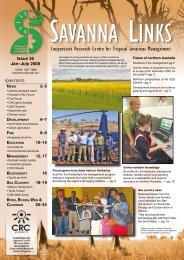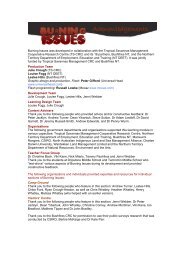Score Sheets for TRARC - EnviroNorth
Score Sheets for TRARC - EnviroNorth
Score Sheets for TRARC - EnviroNorth
Create successful ePaper yourself
Turn your PDF publications into a flip-book with our unique Google optimized e-Paper software.
Tropical Rapid Appraisal of Riparian Condition (<strong>TRARC</strong>). Version 1: August 2006http://savanna.cdu.edu.auNote: Read the User guide be<strong>for</strong>e using these score sheets.Circle most appropriate score.CANOPY COVER 1% cover of trees and tall shrubs >5 m in height.Look directly above you (approx. 5 m radius).Include weedsPointA B C3 m tall. Look around area(approx. 20 m up and down the transect).Do not include weeds. Size groups: 40 cmPointA B CNo canopy, few trees or all same size group 1 1 12 distinct size groups 3 3 33+ distinct size groups 5 5 5Choose a maximum of three species as co-dominants OR in tallclosed <strong>for</strong>est with diverse species assess entire tree communityDateStream nameSite numberTransect numberLeft / Right bank(when facing downstream)AssessorÕs name/sGPS (start of transect)FlowRight bankPoint ‘A’FlowPoint ‘A’LeftRightGPS (end of transect)Average channel width (m)near points A, B, C A B C AveAverage riparian width (m)or width of distinct veg. type A B C AvePhoto numbersRight bankCANOPY HEALTH 2Canopy health of surrounding NATIVE trees andtall shrubs >5 m in height. Look around area(approx. 20 m up and down the transect).Do not include weedsCanopy very sparse/non-existent; shrubs and/orgrasses common due to lack of canopy; deadtrees may occurTree canopy sparse; individuals exhibit crowndieback; dead trees commonCanopy +/– sparse or lacking vigour; dead treesmay be evident; minor crown diebackCanopy slightly irregular and/or with some gaps;no/few dead treesTree canopy appears intact; no/few standingdead trees<strong>Score</strong> sheets — page 1 of 6PointA B C1 1 12 2 23 3 34 4 45 5 5DOMINANT TREE REGENERATION 4Number of juveniles 0.3–3 m tall of dominanttree species. Must be same species as measuredin ‘Tree size classes’. (Look within approx. 5 mradius)PointA B C0 1 1 11–3 3 3 34+ 5 5 5OTHER TREE REGENERATION 5Number of juveniles present that are commonriparian species, even though adult individualsof these species are not dominant within thetransect. (Look within approx. 5 m radius)PointA B C0 1 1 11–3 3 3 34+ 5 5 5A transect is 100 m in lengthRiparianzoneSavanna orfloodplainOne transect in narrow oruni<strong>for</strong>m riparian zones.A transect is 5–20 m wide.Point ‘B’Point ‘C’Point ‘B’Point ‘C’Type 1Type 2One transect centred in each distinctvegetation type on benched banks.Each transect is 5–20 m wide.Transects are 100 m in lengthType 3 Savanna orfloodplain
Mud mapInclude the approximate distances from distinctlandmarks to help others find this site in the future.Example only, not to scale.<strong>Score</strong> sheets — page 2 of 6
MIDSTOREY COVER 6MIDSTOREY WEEDS 7GRASS COVER 6GRASS WEEDS 7% cover of shrubs and small trees1.5–5 m in height (natives andweeds) (5 x 5 m square)PointA B CWhat is the proportion of weeds(same 5 x 5 m square)PointA B C% cover of grass of any height(natives and weeds) (5 x 5 msquare)PointA B CWhat is the proportion of weeds(same 5 x 5 m square)PointA B C
EXPOSED SOIL 8% cover of exposed soil and ash. Exclude large natural rock <strong>for</strong>mations,boulders, leaf litter and roots (5 x 5 m square)BANK STABILITY: Bank sediment size 9Bank sediment size(near the three points A, B, C)MaximumPointA B C80–100% 1 1 160–80% 2 2 230–60% 3 3 35–30% 4 4 410cm diameterand >3 m in length)HIGH IMPACT WEED DISTRIBUTION 14Description of weed distribution within 100 mtransect (up to 20 m wide)Continuous dense distribution in a wet/dry zoneContinuous dense distributionContinuous distribution with some spacesContinuous distribution of well spaced plantsSeveral well spaced patchesA few patches plus several scattered individualsA few patchesA single patch plus several scattered individualsSeveral scattered individualsA single patch plus a few scattered individualsA single patchA few scattered individualsRareDistributionpatternSCORENo high impact weeds in transect 51234BANK STABILITY: Bank slope 10LARGE TREES 11HIGH IMPACT WEEDS 13High impact weed species (<strong>for</strong> Top End, NT and Burdekin, Qld)Approximate bank slope(near the three points A, B, C)70°45°0°PointA B C>70° slope(or undercut) 5 5 545–70° slope 3 3 330 cm trunkdiameter when measured1.3 m from base of trunk,do not include dead orfallen trees. (100 m transect)SCORE0 11–4 25–6 37–8 49+ 5TALLYNumber of listed species(100 m transect) SCORE4 of listed species present 13 of listed species present 22 of listed species present 31 of listed species present 40 of listed species present 5■ Andropogon gayanus(gamba grass)■ Calopogonium mucunoides(calopo)■ Centrosema molle (centro)■ Cryptostegia grandiflora(rubber vine)■ Hymenachne amplexicaulis(olive hymenachne)■ Hyptis suaveolens (hyptis)■ Ipomoea quamoclit(morning glory)■ Lantana camara (lantana)■ Leucaena leucocephala(coffee bush)■ Mimosa pigra (mimosa,giant sensitive plant)■ Panicum maximum (guinea grass)■ Parkinsonia aculeata (parkinsonia)■ Parthenium hysterophorus(parthenium)■ Passiflora foetida(wild passion fruit)■ Pennisetum sp. (mission grass)■ Ricinus communis(castor oil plant)■ Senna alata (candle bush)■ Stachytarpheta spp. (snakeweed)■ Urochloa (Brachiaria) mutica(para grass)■ Xanthium strumarium (noogooraburr)■ Ziziphus mauritiana(chinee apple)
CANOPY WEEDS 15Proportion of canopy plants (>5 m tall) that are weeds,including vines in the canopy (100 m transect)CANOPY CONTINUITY 16Proportion of transect length that has a canopy. Gapsbetween canopies must be >5 m and span the widthof the transect (max 20 m). (100 m transect)SCORE
FIRE 20Time since fire Average fire impact <strong>for</strong> transect SCOREBurnt in current/most recent fireseasonBurnt in previousfire seasonLong unburnt(old fire scars)Little evidenceof fireNotes <strong>for</strong> TREE CLEARING 21* Buffer width is the uncleared vegetation measured from the topof the outermost bank to the nearest cleared land away from thewaterway, OR if no bank exists (drainage lines and wetlands), fromthe outer edge of seepage line or maximum flood level.** Clearing width refers to areas that have had mass tree removal(e.g. <strong>for</strong> grazing, horticulture, car parks, roads, picnic grounds,camping and urban uses).*** Riparian width is measured from the edge of the channel (lowflow) to where there is a distinct change in vegetation andland<strong>for</strong>m.<strong>Score</strong> sheets — page 6 of 6Major impact: canopy burnt and/orburnt up to channel edgeModerate impact: trunks charred butcanopy mostly unburnt and not burntup to channel edgeMinor impact: some impact to riparianboundary or spot fire onlyMajor impact: canopy burnt and/orburnt up to channel edgeModerate impact: trunks charred butcanopy mostly unburnt and not burntup to channel edgeMinor impact: some impact to riparianboundary or spot fire only—> 2—> 1543432TREE CLEARING 21Waterwaytype (pickone only)Drainagelines andintermittentstreams (1st,2nd order)Creeks (3rd,4th order)Rivers(5th orderor greater)Average buffer width(m)* <strong>for</strong> 100 mtransect (measuredaway from waterway)RW 5RW 325 or uncleared any 1RW 5RW 4RW 3RW 2100 or uncleared any 1RW 5RW 4RW 3RW 2250 or uncleared any 1FLOW REGIME: Large dams 22Large dam upstream and vegetation response toenvironmental flows (within 100 m transect)Large dam upstream and environmental flows ineffectiveat triggering recruitment events <strong>for</strong> plants high up bank:tree regeneration rare on high banksLarge dam upstream and environmental flows moderatelyeffective at triggering recruitment events <strong>for</strong> plants highup bank: some tree regeneration on high banksLarge dam upstream and environmental flows effectiveat triggering recruitment events <strong>for</strong> plants high up bank:tree regeneration common on high banksSCORENo large dam upstream 1BANK STABILITY: Instream structures 23Human-built instream structures within 200 m upstreamor downstream of transect (e.g. bridges, culverts, weirs,small dams)531SCORE4+ instream structures 53 instream structures 42 instream structures 31 instream structures 2No instream structures 1OTHER 24Proportion of transect impacted by human structures oractivities that have not yet been recorded. e.g. sand mining,residential/urban development, slashed grass, 4WD track orcrossing, boat ramp, bush camp, hard footpath, walking track,fishing site, pumps, pipes, gauging station (100 m transect)SCORE50–100% 525–50% 410–25% 35–10% 2









